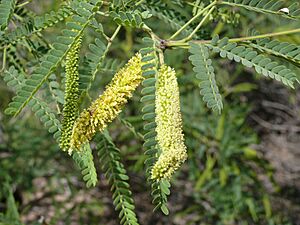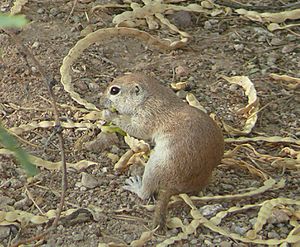Velvet mesquite facts for kids
Quick facts for kids Velvet mesquite |
|
|---|---|
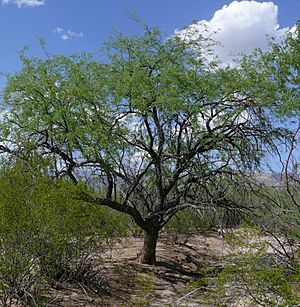 |
|
| Scientific classification | |
| Genus: |
Prosopis
|
| Species: |
velutina
|
The Prosopis velutina, often called velvet mesquite, is a small to medium-sized tree that lives for many years. It's a type of legume, which means it's part of the pea and bean family. This tree is perfectly suited for dry, desert areas. Even though some places outside its natural home consider it a problem plant, it's super important for the environment in the Sonoran Desert.
Contents
Where it Lives
Velvet mesquite trees naturally grow in the Sonoran, Mojave, and Chihuahuan Deserts. You can find them in desert grasslands and near dry riverbeds called washes. They usually grow at elevations below 4,000 to 5,000 feet. Most velvet mesquites are found in central and southern Arizona and in nearby Sonora, Mexico. Near rivers or streams, these mesquites can form small forests called bosques. These forests lose their leaves in winter.
What it Looks Like
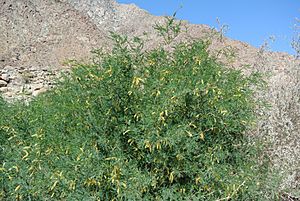
Velvet mesquite trees can grow quite tall, sometimes reaching 30 to 50 feet (9 to 15 meters) or even more! They grow bigger when there's plenty of water, but stay smaller in open, dry grasslands. Their youngest branches are often green and can do photosynthesis, just like leaves.
When the bark is young, it's smooth and reddish-brown. As the tree gets older, the bark turns a dark, dusty gray or brown and looks shredded. Young branches have yellow thorns that can be up to an inch long. The leaves are about 3 to 6 inches (7.5 to 15 cm) long. They are very fine and made up of many tiny leaflets, which is called bipinnately compound. A cool thing about these leaves is that they fold up at night!
The tree has a very long main root called a taproot. This root goes deep into the ground, much deeper than the tree is tall. It helps the tree find water sources that most other plants can't reach. Roots can go about 50 feet (15 meters) deep, but some have been found as deep as 175 feet (53 meters)!
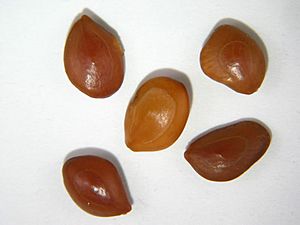

Velvet mesquite is a deciduous tree, meaning it loses its leaves in winter. New leaves grow back in the spring once the weather is warm enough. Because of its deep root system, it usually keeps its leaves even during the dry summer months, unless there's a very bad drought.
The flowers are yellow and grow in spring, after the leaves appear. They form in thick, tube-shaped clusters called catkins, which are about 4 inches (10 cm) long. After the flowers, long seedpods (which are also legumes) start to grow. When they are young, they are bright green and look a bit like pea pods. When they are mature and dry, the pods become hard and contain several hard, dry, brown seeds.
For the seeds to grow, they need to be "scratched" or damaged a little bit, a process called scarification. This usually happens when animals eat the seeds. The seeds pass through the animal's digestive system, which scratches them. Then, the animals spread the seeds widely when they poop them out, as it takes a few days for the seeds to pass through.
Ecology and Importance
The mesquite tree is very important for the desert environment. Many animals eat mesquite pods, including Coyotes, round-tailed ground squirrels, collared peccaries, mule deer, white-tailed deer, and jackrabbits. Farm animals like cattle also eat them when they are available. Birds like to eat the flower buds.
Since mesquites are part of the legume family, they help the soil by adding nitrogen to it. This process is called nitrogen fixation, and it makes the soil healthier for other plants. Mesquites can also act as "nurse trees" for young cacti, like the tall saguaro. This means the mesquite's branches provide shade and protection for the young cacti as they grow. The shade also helps protect small mammals, especially those that dig burrows.
Long ago, Native Americans used mesquite seeds for food, grinding them into a flour. The bark was used to make baskets and fabrics. The wood was used for firewood and building. They also used the leaves and a sticky substance called gum from the tree as medicine.
The areas where velvet mesquite grows have changed over time, partly because of grazing animals. Cattle not only spread mesquite seeds, but they also ate too much grass, which meant fewer wildfires happened. Wildfires used to help control how many mesquite trees grew. Because of this, mesquites grew more thickly and spread into areas that used to be only grassland.
As a result, velvet mesquite is now considered an invasive species or a problem plant in some states. However, the mesquite bosques (forests) today cover much less land than they did before people settled there. Farming, cutting wood for fires, building homes, and lower water tables have all caused the loss of native mesquite tree areas.
Uses for People
- Velvet mesquite is a popular choice for xeriscaping (landscaping that uses little water) in cities like Tucson and Phoenix. These cities are within the tree's natural home. Once a mesquite tree is established, it needs very little watering and looks nice as an ornamental plant.
- Medicinal uses: People used to make a hot tea from the clear sap and inner red bark to treat sore throats. A tea made from fresh leaves helped with stomachaches. Chewing the soft inner bark of the root was used for toothaches. If someone didn't feel like eating, they would drink a tea made from dried leaves before meals.
- Cosmetic uses: Some people used a special black sap that oozes from mesquite wounds, mixed with other secret herbs, to help with hair loss. This was mainly used by men. You can still find special mesquite herbal soap for "macho" hair in some parts of Mexico.
- Crafts: The bark was used to make baskets and fabrics.
- Wood: The wood is important for firewood and gives a great flavor when grilling meat.
Food from Mesquite
Mesquite pods are an important food source for both humans and wild animals. The pods are considered a "slow-release" food. This is because they contain special gums called galactomannins. These gums help to lower how quickly sugar enters your blood, which is called the glycemic response. The glycemic index of mesquite pods is 25%, which is much lower than sweet corn (60%) or white sugar (100%).
When dried and toasted, the pods can be ground into mesquite meal and mesquite flour. Both the flour and meal are used to make tasty cakes, breads, muffins, and pancakes.
See also
 In Spanish: Prosopis velutina para niños
In Spanish: Prosopis velutina para niños



